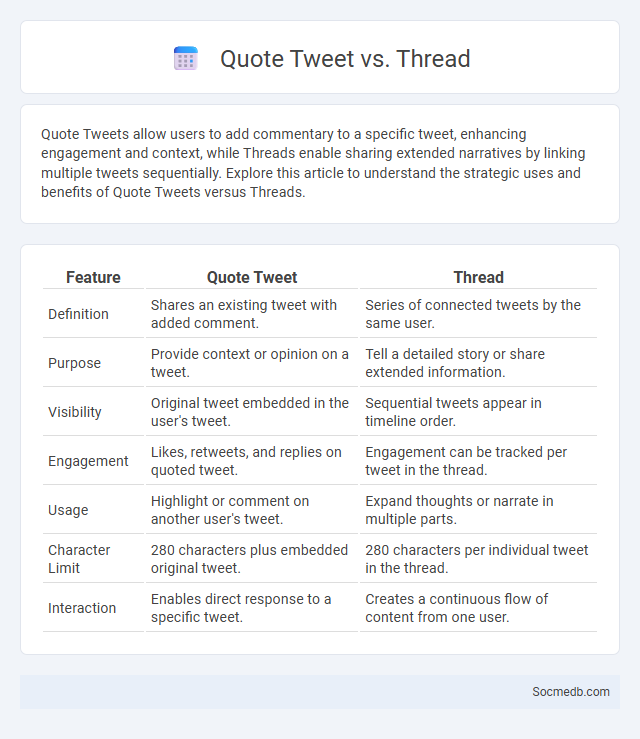
Photo illustration: Quote Tweet vs Thread
Quote Tweets allow users to add commentary to a specific tweet, enhancing engagement and context, while Threads enable sharing extended narratives by linking multiple tweets sequentially. Explore this article to understand the strategic uses and benefits of Quote Tweets versus Threads.
Table of Comparison
| Feature | Quote Tweet | Thread |
|---|---|---|
| Definition | Shares an existing tweet with added comment. | Series of connected tweets by the same user. |
| Purpose | Provide context or opinion on a tweet. | Tell a detailed story or share extended information. |
| Visibility | Original tweet embedded in the user's tweet. | Sequential tweets appear in timeline order. |
| Engagement | Likes, retweets, and replies on quoted tweet. | Engagement can be tracked per tweet in the thread. |
| Usage | Highlight or comment on another user's tweet. | Expand thoughts or narrate in multiple parts. |
| Character Limit | 280 characters plus embedded original tweet. | 280 characters per individual tweet in the thread. |
| Interaction | Enables direct response to a specific tweet. | Creates a continuous flow of content from one user. |
Introduction to Twitter Engagement Features
Twitter engagement features include likes, retweets, replies, and quote tweets, which allow users to interact with content in diverse ways. Your ability to leverage Twitter polls and hashtags can enhance visibility and foster community discussions. Understanding these tools helps boost interaction rates and grow your social media presence effectively.
What is a Quote Tweet?
A quote tweet is a feature on Twitter that allows users to share someone else's tweet while adding their own commentary or context above it. This function helps increase engagement by encouraging discussion and providing additional perspective without altering the original message. Quote tweets enhance information sharing by combining original content with personalized opinions or reactions, making conversations more dynamic on social media platforms.
Understanding Twitter Threads
Twitter threads enhance your ability to convey complex ideas by linking multiple tweets into a cohesive narrative. Each tweet in a thread contributes to a broader discussion, increasing engagement through detailed information and storytelling. Mastering the structure and pacing of Twitter threads boosts your influence and fosters deeper connections with your audience.
Quote Tweet vs Thread: Key Differences
Quote Tweets highlight specific content by embedding an original tweet within a new message, allowing users to add personal commentary while maintaining the original context. Threads consist of multiple connected tweets authored by the same user, enabling a detailed narrative or discussion broken into sequential parts. The key difference lies in the structure: Quote Tweets amplify existing tweets with added opinion, whereas Threads create organized, original multi-part content.
Advantages of Using Quote Tweets
Quote Tweets enhance engagement by allowing you to add personal commentary to shared content, increasing interaction and visibility. They provide context and insight, encouraging deeper conversations and fostering community connections on platforms like Twitter. Utilizing Quote Tweets effectively can amplify your message, driving more traffic to your profile and expanding your social media reach.
Benefits of Twitter Threads
Twitter threads enhance your ability to convey detailed stories or complex ideas by connecting multiple tweets in a clear, organized sequence. They boost engagement by encouraging followers to interact through retweets, likes, and replies across several related posts. This format increases visibility and reach, helping you build a loyal audience more effectively than single standalone tweets.
Common Use Cases for Each Feature
Social media platforms commonly utilize features like photo sharing to enhance visual storytelling, messaging for real-time communication, and groups to foster community engagement around shared interests. Video streaming serves as a powerful tool for live interaction and content promotion, while stories offer ephemeral content that encourages frequent user engagement. Hashtags play a crucial role in content discovery and trend participation, enabling users to connect and share around specific topics.
Content Strategy: When to Use Which
Effective content strategy on social media hinges on understanding the unique strengths of each platform to maximize engagement and reach. Your choice between Instagram for visual storytelling, LinkedIn for professional insights, Twitter for real-time updates, or TikTok for viral short-form videos should align with your target audience's preferences and behavior. Timing and content format optimized to platform-specific algorithms significantly boost your visibility and interaction rates.
Impact on Audience Engagement
Social media platforms significantly enhance audience engagement by enabling real-time interaction, personalized content delivery, and community building around shared interests. Algorithms tailor content to Your preferences, increasing the likelihood of meaningful interactions and prolonged attention. This dynamic environment fosters higher engagement rates, including likes, shares, comments, and user-generated content, driving brand loyalty and deeper connections.
Final Thoughts: Choosing the Right Twitter Tool
Selecting the right Twitter tool can dramatically improve your social media management efficiency and engagement. Prioritize features like scheduling capabilities, analytics insights, and user-friendly interfaces to maximize your productivity. Your choice should align with your specific goals, ensuring seamless integration with your overall marketing strategy for optimal results.
 socmedb.com
socmedb.com